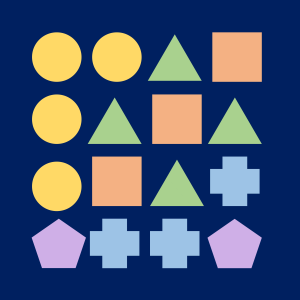Visual Development and Object Recognition
115
Learning Objectives
Be able to explain the six Gestalt principles, e.g. pragnanz, similarity, etc.
Know what Gestalt principles can help us with understanding visual perception.
The first Gestalt principle is figure-ground relationship which we piece the world visually into figure then ground. Figure explains the object that our field focuses on, while ground is our background information. The ability to interpret our sensory information is based on what is perceived as figure and what is perceived as ground (Peterson & Gibson, 1994; Vecera & O’Reilly, 1998).
The second principle that we tend to use is similarity, in which we take visual information and interpret it into groups. For example, when we see a picture with various shapes, we tend to group shapes that are similar to one another rather than different shapes.
We might also use the principle of continuity where we tend to see the stimuli perceived in a smoother, continuous way compared to a discontinuous way. In a figure that has dotted lines, we tend to see a straighter line instead of a line that is more jagged.
Another principle that we use is proximity, where we organize and group things together in a way where it is meaningful in terms of perception. This means that in the visual information that we perceive, things that are closer to each other are more likely to be grouped together (Fig.11.8.1).
Also, we organize what we perceive into complete objects rather than incomplete, which is the closure principle. When we see a square that may be fragmented, we are more likely to perceive it as a complete square.
The last principle that we tend to use is pragnanz, which coincides with the principles of continuity and closure where we perceive objects as concise or meaningful. This means that certain information that is familiar to us makes it harder to be perceived as something different.

Gestalt’s principles can help us understand visual perception because one of the required processes that is within our vision is form. We create forms out of sensation components based on Gestalt. The word “gestalt” stems from the idea of making meaning of patterns and perceiving information as a meaningful, organized whole. It considers the idea of the whole being different from the sum of the included parts. This means that our brains are able to create a predictable perception that is more than the sum of its sensory inputs. The part that is predicted is translated into sensory information which can be organized.
Introduction to Psychology
Provided by: University of Minnesota
URL: https://open.lib.umn.edu/intropsyc/
License: CC BY NC SA 4.0

